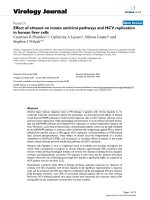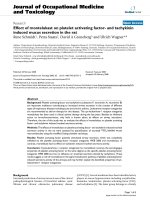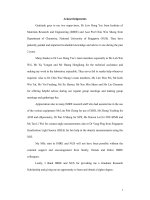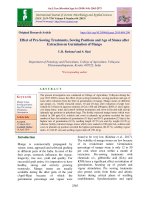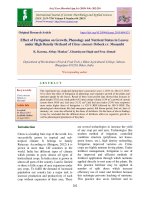Effect of mulching on cultivation, weed control and moisture conservation in bitter gourd (Momordica charantia L.)
Bạn đang xem bản rút gọn của tài liệu. Xem và tải ngay bản đầy đủ của tài liệu tại đây (408.12 KB, 10 trang )
Int.J.Curr.Microbiol.App.Sci (2018) 7(7): 3341-3350
International Journal of Current Microbiology and Applied Sciences
ISSN: 2319-7706 Volume 7 Number 07 (2018)
Journal homepage:
Original Research Article
/>
Effect of Mulching on Cultivation, Weed Control and Moisture
Conservation in Bitter Gourd (Momordica charantia L.)
Lovepreet Singh and Sukhwinder Singh Aulakh*
Department of Horticulture, School of Agriculture, Lovely Professional University, Phagwara
(Punjab), India 144401
*Corresponding author
ABSTRACT
Keywords
Vitamin C,
Moisture
conservation, Juice
percentage, Weed
control.
Article Info
Accepted:
24 June 2018
Available Online:
10 July 2018
Bitter gourd is an important commercial vegetable crop not only in India but also in whole of southeast Asia. Its fruits contain several active compounds and have many medicinal uses as evident from
old texts as well as its popularity in modern medicine. Due to limited irrigation facilities and stress
on natural resources, getting high yields with minimal input is vital for agriculture in the current
scenario and judicious selection and use of mulching can play a big role in water conservation. In
order to access the role of mulching on growth, yield and quality traits of bitter gourd, a field
experiment was conducted at the Experimental Farm of School of Agriculture of Lovely Professional
University, Phagwara during the cropping season of March- July 2017. The experiment consisted of
five treatments of different mulch materials (plastic, pebble, straw, FYM and control) applied to
plots of bitter gourd variety Leena and treatments were assigned in a Randomized Complete Block
Design with three replications. Data on plant growth, yield, earliness, weed growth, weed density
and soil moisture conservation were recorded and analyzed with the SPSS package and charts and
table were drawn in excel. Although,the effect of different mulch materials on various plant growth
parameters of bitter gourd such as vine length (m), numbers of branches per plant were nonsignificant; mulching was responsible for earlyflowering and results were significant. Flowering was
early by one week when plastic mulch (34 days) was used and late by four days in FYM mulch (44
days) when compared to control (40 days). The higher yields as measured in terms of number of
fruits per plant (25 fruits) and total fruit yield per plant(1.86kg) were obtained when straw mulch was
used followed by plastic and control. Mulching also affected the fruit size and the largest fruit
(14.47cm) was measured in plastic mulch and minimum smallest fruit sizes were recorded in straw
(13.60cm) and FYM mulch (13.62cm). Two quality parameters viz., juice percentage and vitamin C
were also observed and the highest juice percentage (24.86%) was observed by use of FYM mulch
material followed by use of pebble (22.91%) and lowest juice percentage was observed with plastic
mulch (19.21%). In case of vitamin C, highest reading was recorded in pebble (84.08mg/100gm) and
least was recorded in FYM (69.65mg).Mulching in general was also very effective in controlling
weeds and in conserving the soil moisture. Plastic mulch effectively controlled both the weed species
(Nut grass and Crab grass) and also retained the highest soil moisture content (24%).
Introduction
Bitter gourd (Momordica charantia L.) is one
of the bitterest fruits that belongs to
Cucurbitaceae family and its chromosome no.
is 2n=2x=24. The center of origin of bitter
gourd is Indo-Burma and it is widely grown in
Southeast Asia, Africa, Philippines, Japan,
China, Pakistan, the Caribbean, South
America, Bangladesh, Shri Lanka, Nepal and
India as a food and medicine. Moreover, in
India it is widely spread in many states like
Punjab, Haryana, Uttar Pradesh, Bihar,
Gujarat, Maharashtra, Odisha, West Bengal,
3341
Int.J.Curr.Microbiol.App.Sci (2018) 7(7): 3341-3350
Tamil Nadu etc. (Gupta et al., 2011). Bitter
gourd is an herbaceous vine that grows up to
six meters in length. It bears simple, alternate
leaves 5-13cm across, with 4-6 deeply
separated lobes and plant bears monoecious
flowers (Gupta et al., 2011).Bitter Gourd has
many essential antioxidants, vitamins,
bioactive chemicals and minerals which are
useful in treating a wide range of illnesses. It
is useful against diabetes, controlling blood
sugar level and offer many health benefits.
Around 228 different medicinal compounds or
molecules were isolated from the leaves, stem,
callus tissue, endosperm of the plant. It is used
as traditional medicine to cure asthma, cough,
diabetes, fever, skin diseases, ulcers and
wounds. Secondly, bitter gourd fruit is used as
blood purifier and prevents liver damage
(Panday et al., 2014).
Bitter Gourd is cultivated up to the altitude of
1500m and it is an annual or perennial
climber. It is cultivated during warm and rainy
season i.e. during April-July and the duration
of the crop is about three to four months. The
optimum temperature required for plant
growth is in the range of 24-270C and
optimum
soil
temperature for seed
0
germination is 18 C. The plant is adapted to
rain fed conditions, but regular irrigation
ensures high yield when there is no
rainfall.Bitter gourd prefers a well-drained
sandy loam soil, it should be rich in organic
matter and the optimum pH of soil should be
6-6.7, but plants can tolerate up to pH 8.0
alkaline soil. First harvesting of fruit is done
20-25days after fruit setting. Average fruit
yield is 14t/ha (Ibarra et al., 2001), but can be
increased by adopting various agronomic
practices.
During 2016-2017 cropping season the total
area under bitter gourd was 96,000 hectare
producing total of 1085 tonnes of fruits. The
average productivity was 11 tonnes per
hectare in the both 2016-2017.In bitter gourd
cultivation, mulching (German molsch
meaning soft to decay) is very useful for
controlling various types of weeds, conserving
moisture and checking soil erosion. Mulching
acts as protecting covering, and could be of
organic (straw, FYM, rice hull, leave residue
etc.) or inorganic material line plastic sheets of
different colors and pebbles etc. Good mulch
controls the variation in temperature and
improves the physical, chemical and
biological properties of soil. The organic
mulches also add humus and nutrients. In
general, it is found that in various vegetable
crops, mulching boosts up yield by 20-60%
over no mulch (Patil et al., 2013) as described
in Table 1.
In the present study we evaluated the effect of
different types of mulches on growth, yield
and quality of bitter gourd. Additionally,
effect of different mulches in weed control
and on soil moisture conservation was also
evaluated. Bitter gourd vines have a trailing
growth habit. The vines can spread on ground
or these can also be trained vertically on a
suitable training framework. In either case
weeds can pose major challenge in the initial
growth
period
therefore
the
suppression/control of weeds is important.
Later on, during advanced plant growth stage;
the big leaves of the crop can smoother the
weeds and therefore study of type and density
of weeds is important in order to device
suitable weed control methodology.
Another important benefit that can be
associated with use of mulching is water
conservation. It is well known that different
types of mulching material are capable of
conserving the soil moisture to a varying
degree. Bitter gourd is a broad leaf crop but in
the beginning the crop growth is slow and due
wider planting distance most of the soil is
exposed the environment factors leading to
high rate of evaporation and moisture loss. A
judicious selection and use of suitable mulch
3342
Int.J.Curr.Microbiol.App.Sci (2018) 7(7): 3341-3350
could prove beneficial in conserving the soil
moisture.
Materials and Methods
The experiment was conducted at Main
Experimental Farm of the Lovely Professional
University Phagwara, Distt. Kapurthala,
Punjab (India), during March – July cropping
season of year 2017. The average minimum
and maximum temperatures during March to
July were 210C to 310C and the soil wasxsandy
100
loam. We evaluated a private sector hybrid of
bitter gourd (Leena F1 hybrid, Sakata Seed
India (P) Ltd., Gurugram, Haryana) for its
performance under five different types of
mulches. The treatments were applied in
Randomized Complete Block Design (RCBD)
with three replications. Planting was done on
raised beds (2m x 2m x 15cm) and total of six
plants were planted on a single bed in two
rows with 100cm row to row and 50cm plant
to plant spacing. A space of 50cm was kept
between the beds. Mulching treatments were
applied 5 days after transplanting the crop to
the main field.
Data were recorded on various plant growth
parameters like vine length, number of
branches to main vine, days to first flower;
yield parameters viz., fruit length, number of
fruits per plant, average weight of single fruit
(g), average fruit yield/plant(kg); quality
parameters viz.,juice percent and vitamin C
content. Data were also recorded on weed
density, growth rate and species richness.
Finally, soil moisture percentage under
different mulches was also determined.
The data for each treatment were reported
after taking the average of 15 readings and
statistical analysis were done on these
averages. For estimation of Vitamin C content
in bitter gourd fruits, Metaphosphoric acid 3%
solution was made by dissolving 30gm in one
liter of distilled water. For titration 2-6-
dichloroindophenol dye was made by first
dissolving 42mg sodium bicarbonate in 120ml
of distilled water and the procedure given in
(Reference) was followed. Readings were
recorded when constant dark pink color was
stable. Calculations were done using this
formula Ranganna (1979).
Ascorbic acid (mg/ 100gm) =
Titrate vol. (ml of dye used) × dye
factor × vol. made up
Aliquot of sample taken for
estimation × vol. of sample
Similarly, Juice percentage was determined by
dividing the weight of bitter gourd juice
extracted with weight of bitter gourd fruit
before extracting the juice and multiplying by
100.
Observations on weed control were recorded
at the time of first flowering. Number of
weeds was counted in a predetermined fixed
area of 0.25m2 (50cm X 50cm plot) as shown
in Figure 1. For species richness we observed
the total number of weed species in the above
said plot and for determining the growth rate,
plant height of weeds were measured at 2-day
interval for a week.
To determine soil water conservation, random
soil samples were taken from single plot of
each replication and samples were combined
and later a composite sample was drawn for
analysis. From the composite sample, 100 g of
soil were taken and dried in hot air oven for
24hours at 100°C. Readings were recorded
when constant weights of sample were
reached.
Soil Moisture Percentage =
Fresh weight – Dry weight
Dry weight
x 100
Data were analyzed using Excel (2013) and
3343
Int.J.Curr.Microbiol.App.Sci (2018) 7(7): 3341-3350
SPSS version 17 (2016) package. Analysis of
variance (ANOVA) tables were drawn with
SPSS and graphical presentation (Charts,
Histograms) was done with the help of Excel.
Results and Discussion
Effect of mulch
parameters
material
on
growth
Growth parameters like vine length, number
of branches, days to flower etc. are vital in
determining the crop stand, growth and
ultimately good yield. For each parameter
multiple data points were recorded (for details
see material and method section). Here we are
presenting some of the data as summarized in
Table 2.
Vine length
Different types of mulching material used in
this study do not have any significant effect on
vine length of bitter gourd as shown in Table
2.
Vine length at 105 DAS was maximum straw
mulch (4.74m) followed by FYM (4.70m) and
least was observed in pebbles mulch (4.62m).
In a study on cucumber the authors recorded
highest and significant vine length by using
rice hull mulch (Ekwu et al., 2012). In the
current study the highest vine length was also
achieved in Straw material (4.74m), although
this is not significantly different from other
mulching materials.
Days to first flowering
Significant differences were observed among
different mulch treatments on number of days
taken for first flowering. Plastic mulch had
taken less number of days (34) followed by
straw mulch (37), pebble (38) and control
(40). Whereas, FYM (44) has taken more
number of days for first flower.
First flowers could be attributed to the
increased soil temperature of plastic mulch
which was directly related to early initiation of
flowers. Similar variations were also recorded
by (Khan et al.2015) in sponge gourd and
watermelon (Parmar 2011 and Parmar et
al.2013). Days to flowering is considered a
very important trait in vegetable since
precocious yield are capable of fetching
premium price in the market. Based on our
data plastic mulching can advance the crop by
about one week.
Effect of mulch
parameters
material
on
yield
Yield parameters like fruit length (cm),
number of fruits per plant, average weight of
single fruit (gm), average fruit yield (kg) etc.
are vital in for determining the good yield.
The effects of mulching treatments on fruit
length of bitter gourd (average of various data
points) were found to be significant. Data have
been presented in Table 2 and Figures 2 and
3A. Among all these mulching material the
maximum fruit length were observed in plastic
mulch (14.47cm) followed by pebble and
control (14.37cm) and least was observed in
straw mulch (13.60cm). Similar variation was
also recorded by (Khan et al., 2015) sponge
gourd and (Sylvestre et al., 2014) water
melon.
The effect of mulching treatments on
maximum number of fruit from plot was
mainly due to increasing number of primary
and secondary branches per plant, and number
of fruits per plant. Significant differences were
observed among different mulch applications.
Straw mulch produced maximum fruits
(25.17) followed by plastic and FYM mulch
(23.28) and control mulch (23) while,
minimum number of fruits were observed in
pebble mulch (22.61) which were on par with
each other. Similar variations were also
recorded by (Birbal et al., 2014) squash
melon.
3344
Int.J.Curr.Microbiol.App.Sci (2018) 7(7): 3341-3350
Table.1 Yield comparison in vegetable crops with and without use of plastic mulching
Crop
Yield (t/ha)
Increase in
No mulch
With mulch
yield (%)
Bitter Gourd
20.12
25.63
27.39
Broccoli
14.20
26.25
61.85
Cauliflower
18.85
26.24
60.78
Brinjal
37.63
44.61
27.34
Tomato
68.25
87.84
34.57
Okra
6.14
9.38
25.44
Table.2 Mean values of observed plant parameters of bitter gourd under different mulching
materials
Parameter
Vine length 105DAS
(m)
Days to first flowering
Fruit length (cm)
No. of fruits per plant
Average weight of
single fruit (gm)
Average fruit
yield/plant (kg)
Juice percent (%)
Vitamin C (mg/ 100gm)
Weed density of nut
grass
Weed density of crab
grass
Species richness
Growth rate of nut grass
(cm)
Growth rate of crab
grass (cm)
Soil moisture (%)
Mean values + SE
Plastic Control FYM Straw Pebble
4.65±0.38
4.70±0.23
4.74±0.59
N
6
4.68±0.04
4.62±0.20
P
Value
0.319
6
15
15
15
34a±1.15
40b±0.58
44c±0.58
37b±0.33
38b±1.20
14.47a±0.11 14.37b±0.09 13.62c±0.18 13.6c±0.02 14.37b±0.11
23.33b±0.09 23b±0.0923.28b±0.1525.17a±0.0922.61c±0.15
72.29±1.25
70.25±0.53
69.5±0.79
69.49±0.48
71.95±0.98
0.000⁕
0.000⁕
0.000⁕
0.115
15 1.78b±0.0081.73b±0.0031.59c±0.011.86a±0.041.57c±0.02
0.000⁕
3 19.21c±0.86
3 73.14c±0.57
25 2d±0.33
2
0b±0.33
20.27bc±1.64 24.86a±0.69
75.92b±0.29 69.65d±0.42
26a±0.88
13b±0.66
19.92bc±0.78 22.91ab±0.89
74.28bc±0.51 84.08a±0.83
9c±0.57
1d±0.577
0.015⁕
0.000⁕
0.000⁕
2a±0.577
0b±0.00
0.003⁕
2a±0.33
2 1±0.33
2±0.0
2±0.0
25 21.02c±0.522.83b±0.44 25.5a±0.16
2
0.00b±0.00
6.72a±0.27
2
23.85a±0.49
16.53c±0.52
7.06a±0.29
3345
0b±0.00
1±0.57
1.33±0.66
22.96b±0.09 18.26d±0.55
0.00b±0.00
16.97c±0.57 21.67b±0.00
0.424
0.000⁕
0.00b±0.00
0.000⁕
15.35c±0.57
0.000⁕
Int.J.Curr.Microbiol.App.Sci (2018) 7(7): 3341-3350
Figure.1 Measurement of weed density and species richness in bitter gourd crop grown by using
different mulches
Figure.2 Effect of mulch material on fruit length (A) and average fruit yield (B)of bitter gourd.
Significant effects were observed in case of plastic and straw mulch from all other treatments,
non-significant result were observed in average fruit weight. Significant cut off was based on p
<0.05value
3346
Int.J.Curr.Microbiol.App.Sci (2018) 7(7): 3341-3350
Figure.3 Different fruit quality parameter like shape and size (A) and juice content (B) of bitter
gourd
Figure.4 Quality parameters like juice percentage (A) and vitamin C (B) of bitter gourd by using
various types of mulches
Significant differences were observed among
different mulch applications with respect to
average fruit yield. Straw mulch (1.86kg)
produced the highest yield followed by plastic
mulch (1.78kg), control (1.73kg), FYM
(1.59kg), and lowest yield was produced by
using pebble (1.57kg). Similar variations were
also recorded by (Birbal et al., 2014) in
squash melon.
Effect of mulch material on quality
parameters
In this study two main quality parameters of
bitter gourd fruits viz., juice percentage and
vitamin C content were studied (Figure 3B).
Juice percentage determines the palatability
quality of the fruits and also influence the
vitamin C content.
3347
Int.J.Curr.Microbiol.App.Sci (2018) 7(7): 3341-3350
Bitter gourd juice has many compounds that
have medicinal values and therefore
determining the juice percentage is important.
Significant differences were observed among
different mulching treatments, FYM resulted
in maximum juice recovery percentage
(24.86%) followed by pebble mulch (22.91%)
and least juice percentage (19.21%) were
recorded in plastic mulch. The data (Figure 4)
revealed that there were significant
differences in ascorbic acid (mg/100gm)
content of bitter gourd fruit when grown
under different types of mulching material.
Pebble mulch (84.08mg/100gm fruit weight)
produced highest amount of ascorbic acid
followed by control mulch (75.92mg), straw
(74.28mg) and least were observed in FYM
(69.65mg).
Effect of mulch material on weed growth
and density
We have studied two important weeds of
bitter gourd viz., nut grass and crab grass and
the results are summarized in Table 2. The
data revealed that there were significant
differences in weed density of nut grass and
crab grass, under observed area of0.25m2
(50cm x 50cm plot). For instance, the highest
number of nut grass plants were recorded in
control plot (26) followed by FYM (13),
Straw (9) and very few nut grass plants were
recorded in plastic (2) and pebble (1). In case
of crab grass, there were only sporadic weed
population with only two plants were
observed in control plot and there was no
appearance of this plant in any of the
treatments used in this study. Similar
variations were also observed in summer
squash (Coolong, 2010), tomato (Rajablariani
et al., 2012), chilli (Ashrafuzzaman et al.,
2011). In another study by Schonbeck (1999),
similar results were recorded in major
vegetable crops like capsicum, tomato,
cabbage etc. As already mentioned we studied
two weed species in the present study and
have not observed any other weed species.
Both the weeds were present in control plot
and plot in which FYM were used as
mulching material. In other treatments
(plastic, straw and pebble) only nut grass
weeds were observed. Based on our analysis,
the results of species richness are nonsignificant. Most of the mulch materials were
able to decrease the weed density to a
significant lower level. Some weeds that we
observed in FYM could be present the FYM
material used.
Plant height of weeds were determined and
presented in Table 2 as an indicator of growth
rate. The information revealed that there were
significant differences in the growth rate of
both the weeds when different mulching
material was used. In case of nut grass,
highest plant height was recorded with FYM
mulch (25.50cm) followed by Straw
(25.97cm) and lowest height of weed were
observed in plastic (21.02cm) and pebble
(18.26cm).However in crab grass, which was
reported only in control plot and FYM mulch,
there were no significant differences in the
growth rate. Similar variations were also
observed (Coolong, 2010) in summer squash,
chilli (Ashrafuzzaman et al., 2011).
Effect of mulch
conservation
material
on
water
The data represent in Table 2 exhibited that
effect of mulching treatments on soil moisture
of bitter gourd show significant differences
among different mulch applications. Water
conservation was measured in terms of
percentage of soil moisture content present in
the soil at a given time. Highest soil moisture
percentage were observed in plastic mulch
(23.85%) followed by straw (21.67%) and
lowest were recorded in pebble mulch
(15.35%). Similar variation was also observed
by Rao et al., (2017) and Parmar (2011) in
watermelon, and by (Schonbeck 1999) and
(Awasthi et al., 2006) in brinjal.
3348
Int.J.Curr.Microbiol.App.Sci (2018) 7(7): 3341-3350
From the results of present study, following
broad conclusions can be drawn which may
prove beneficial in commercial cultivation of
bitter gourd.
1. Mulching is useful for getting early
marketable yields: Use of plastic mulch
have advanced the bitter gourd crop by
one week compared to control.
2. Mulching increases the total yield of bitter
gourd: Although all type of mulches were
useful in one way or another the highest
total yield and large fruits were obtained
with plastic mulching.
3. Mulching leads to better quality of
produce: Juice percent was highest when
pebble were used as mulch and FYM
mulch lead to highest vitamin C content.
4. Weed control and moisture conservation:
Both plastic and pebble mulching
effectively controlled the weeds, however
the highestmoisture conservation was
achieved inplastic mulch followed by
straw mulching.
References
Ashrafuzzaman, M., Halim, M.A., Ismail,
M.R., Shahidullah, S.M., and Hossain,
M.A. (2011). Effect of plastic mulch on
growth and yield of chilli (Capsicum
annuum L.) Brazilian Archives of
Biology and Technology, 24 (2): 15168913.
Awasthi, O. P., Singh, I. S., and Sharma, B.
D. (2006). Effect of mulch on soilhydrothermal regimes, growth and fruit
yield
of
brinjal
under
arid
conditions. Indian
journal
of
Horticulture, 63(2): 192-194.
Birbal, Rathore, V.S., Nathawat, N.S., Soni
M.L., and Yadava, N.D. (2014).
Response of squash melon (citrullus
vulgaris var. Fistulosus) to FYM and
mulching under rainfed condition of hot
arid region of Rajasthan. Indian Journal
of Agricultural Research, 48 (2): 1493349
153.
Coolong, T. (2010). Performance of paper
mulches using a mechanical plastic
layer and water wheel transplanter for
the production of summer squash.
Department of Horticulture Science, 20
(2): 319-324.
Ekwu, L.G., Nwokwu, G. N., and Utobo,
E.B. (2012). Effect of mulching
materials and pruning on growth and
yield of cucumber (Cucumis sativus L.).
International Journal of Agriculture
and Rural Development, 15(2): 10141021.
Gupta, M., Sharma, S., Gautam., A.K., and
Bhadauria, R. (2011). Momordica
charantia linn. (karela): nature’s silent
healer. International Journal of
Pharmaceutical Sciences Review and
Research, 11(1): 32-37.
Ibarra, L., Flores, J., and Dıá z-Pérez, J. C.
(2001). Growth and yield of muskmelon
in response to plastic mulch and row
covers. Scientia Horticulturae, 87(1-2):
139-145.
Khan, M., Abid, S., Hussain, Z., and Mateen,
K. (2012). Effect of different weed
control method on weeds and yield of
chillies (Capsicum annuum L.).
Pakistan Journal of Weed Science
Research, 18 (1): 71-78.
Khan, S., Pal, M., and Kumar, V. (2015).
Influence of different mulches on
growth and yield of sponge gourd (Luffa
Clyndrica L.). Plant Archives, 15(1):
393-395.
Panday, D. R., Rauniar, G. P., and
Rajbhandari, M. D. K. (2014).
Momordica charantia (karela); an
antidiabetic.World journal of pharmacy
and pharmaceutical sciences, 4(1): 8499.
Parmar, M. P. (2011). “Effect of mulching
material on growth, yield and quality of
watermelon (Citrullus lanatus Thunb)”
cv.„KIRAN‟ (Doctoral dissertation, jau,
Int.J.Curr.Microbiol.App.Sci (2018) 7(7): 3341-3350
junagadh).
Parmar, H. N., Polara, N. D., and Viradiya, R.
R. (2013). Effect of mulching material
on growth, yield and quality of
watermelon (Citrullus lanatus Thunb)
Cv. Kiran. Universal Journal of
Agricultural Research, 1(2): 30-37.
Patil Shirish, S., Kelkar Tushar, S., and
Bhalerao Satish, A. (2013). Mulching:
A soil and water conservation practice.
Research Journal of Agriculture and
Forestry Sciences.1(3): 26-29.
Rajablariani, H. R., Hassankhan, F., and
Rafezi, R. (2012). Effect of colored
plastic mulches on yield of tomato and
weed biomass. International Journal of
Environmental
Science
and
Development, 3(6): 590-593.
Ranganna S. (1979). Manual of analysis of
fruits and vegetable products. Tata
McGraw Hill Book Company, New
Delhi. p 634.
Rao, K. V. R., Bajpai, A., Gangwar, S.,
Chourasia, L., and Soni, K. (2017).
Effect of Mulching on Growth, Yield
and
Economics
of
Watermelon
(Citrullus lanatus Thunb). Environment
and Ecology, 35(3): 2437-2441.
Schonbeck, M. W. (1999). Weed suppression
and labor costs associated with organic,
plastic, and paper mulches in smallscale vegetable production. Journal of
Sustainable Agriculture, 13(2), 13-33.
Sylvestre, H., Bosco, N. J., Emmanuel, N.,
and Christine, U. (2014). Growth and
yield of watermelon as affected by
different spacing and mulching types
under
Rubona
conditions
in
Rwanda. Scholarly
Journal
of
Agricultural Science, 4(10): 517-520.
How to cite this article:
Lovepreet Singh and Sukhwinder Singh Aulakh. 2018. Effect of Mulching on Cultivation,
Weed Control and Moisture Conservation in Bitter Gourd (Momordica charantia L.).
Int.J.Curr.Microbiol.App.Sci. 7(07): 3341-3350. doi: />
3350
